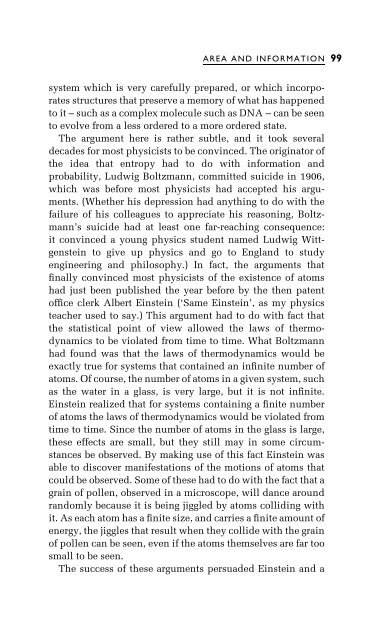Three Roads To Quantum Gravity
Three Roads To Quantum Gravity
Three Roads To Quantum Gravity
Create successful ePaper yourself
Turn your PDF publications into a flip-book with our unique Google optimized e-Paper software.
AREA AND INFORMATION<br />
99<br />
system which is very carefully prepared, or which incorporates<br />
structures that preserve a memory of what has happened<br />
to it ± such as a complex molecule such as DNA ± can be seen<br />
to evolve from a less ordered to a more ordered state.<br />
The argument here is rather subtle, and it took several<br />
decades for most physicists to be convinced. The originator of<br />
the idea that entropy had to do with information and<br />
probability, Ludwig Boltzmann, committed suicide in 1906,<br />
which was before most physicists had accepted his arguments.<br />
(Whether his depression had anything to do with the<br />
failure of his colleagues to appreciate his reasoning, Boltzmann's<br />
suicide had at least one far-reaching consequence:<br />
it convinced a young physics student named Ludwig Wittgenstein<br />
to give up physics and go to England to study<br />
engineering and philosophy.) In fact, the arguments that<br />
®nally convinced most physicists of the existence of atoms<br />
had just been published the year before by the then patent<br />
of®ce clerk Albert Einstein (`Same Einstein', as my physics<br />
teacher used to say.) This argument had to do with fact that<br />
the statistical point of view allowed the laws of thermodynamics<br />
to be violated from time to time. What Boltzmann<br />
had found was that the laws of thermodynamics would be<br />
exactly true for systems that contained an in®nite number of<br />
atoms. Of course, the number of atoms in a given system, such<br />
as the water in a glass, is very large, but it is not in®nite.<br />
Einstein realized that for systems containing a ®nite number<br />
of atoms the laws of thermodynamics would be violated from<br />
time to time. Since the number of atoms in the glass is large,<br />
these effects are small, but they still may in some circumstances<br />
be observed. By making use of this fact Einstein was<br />
able to discover manifestations of the motions of atoms that<br />
could be observed. Some of these had to do with the fact that a<br />
grain of pollen, observed in a microscope, will dance around<br />
randomly because it is being jiggled by atoms colliding with<br />
it. As each atom has a ®nite size, and carries a ®nite amount of<br />
energy, the jiggles that result when they collide with the grain<br />
of pollen can be seen, even if the atoms themselves are far too<br />
small to be seen.<br />
The success of these arguments persuaded Einstein and a



![arXiv:1001.0993v1 [hep-ph] 6 Jan 2010](https://img.yumpu.com/51282177/1/190x245/arxiv10010993v1-hep-ph-6-jan-2010.jpg?quality=85)


![arXiv:1008.3907v2 [astro-ph.CO] 1 Nov 2011](https://img.yumpu.com/48909562/1/190x245/arxiv10083907v2-astro-phco-1-nov-2011.jpg?quality=85)








![arXiv:1002.4928v1 [gr-qc] 26 Feb 2010](https://img.yumpu.com/41209516/1/190x245/arxiv10024928v1-gr-qc-26-feb-2010.jpg?quality=85)
![arXiv:1206.2653v1 [astro-ph.CO] 12 Jun 2012](https://img.yumpu.com/39510078/1/190x245/arxiv12062653v1-astro-phco-12-jun-2012.jpg?quality=85)
